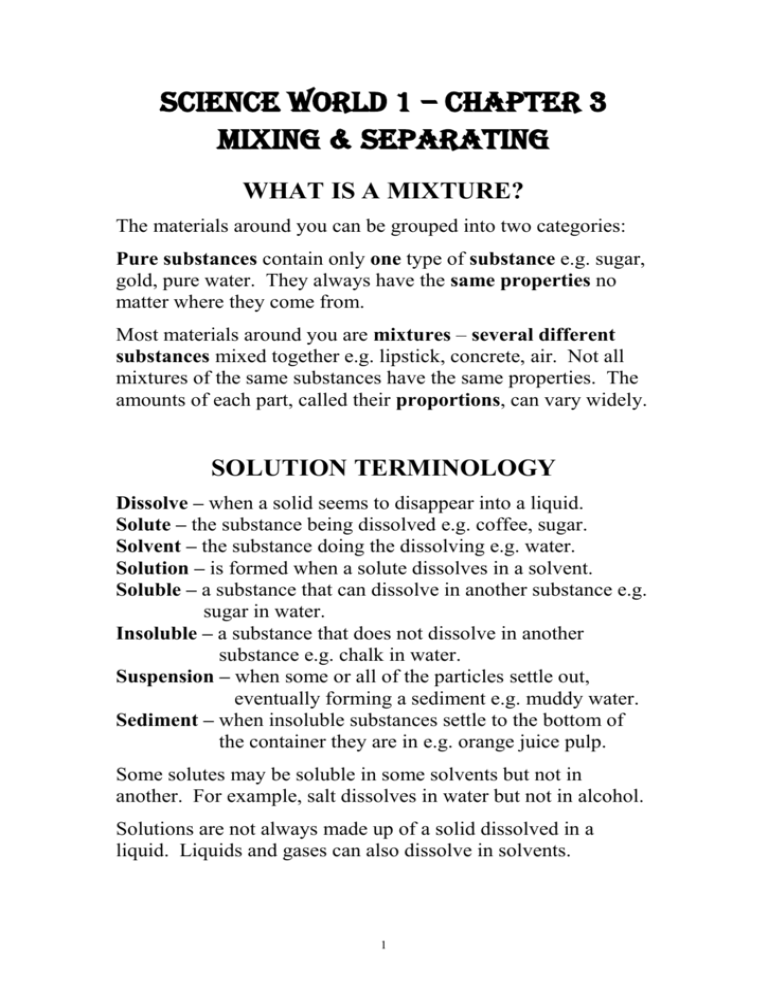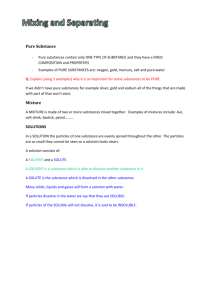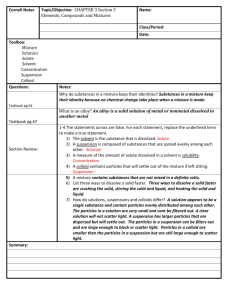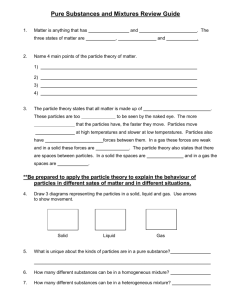Chapter 3
advertisement

science world 1 – chapter 3 mixing & separating WHAT IS A MIXTURE? The materials around you can be grouped into two categories: Pure substances contain only one type of substance e.g. sugar, gold, pure water. They always have the same properties no matter where they come from. Most materials around you are mixtures – several different substances mixed together e.g. lipstick, concrete, air. Not all mixtures of the same substances have the same properties. The amounts of each part, called their proportions, can vary widely. SOLUTION TERMINOLOGY Dissolve – when a solid seems to disappear into a liquid. Solute – the substance being dissolved e.g. coffee, sugar. Solvent – the substance doing the dissolving e.g. water. Solution – is formed when a solute dissolves in a solvent. Soluble – a substance that can dissolve in another substance e.g. sugar in water. Insoluble – a substance that does not dissolve in another substance e.g. chalk in water. Suspension – when some or all of the particles settle out, eventually forming a sediment e.g. muddy water. Sediment – when insoluble substances settle to the bottom of the container they are in e.g. orange juice pulp. Some solutes may be soluble in some solvents but not in another. For example, salt dissolves in water but not in alcohol. Solutions are not always made up of a solid dissolved in a liquid. Liquids and gases can also dissolve in solvents. 1 SOLUBILITY Liquid solutions come in many different strengths. The colour of a solution can often give some idea of the strength of the solution. We describe the strengths of solutions using the following terms: Dilute – small amount of solute in a certain amount of solvent (i.e. weak). Concentrated – large amount of solute in a certain amount of solvent (i.e. strong). Saturated – a solution when no more solute will dissolve in the solvent (i.e. extremely strong). Unsaturated – any solution that can dissolve more solute. The amount of solute needed to saturate a solution depends on the temperature. Most solids are more soluble in warm water than cold water. We say that their solubility increases as the temperature increases. SEPARATING SUSPENSIONS The method we choose for separating suspensions depends on the properties of the substances involved. Decanting – used when you have a solid sediment mixed in with a liquid. You slowly pour the liquid off the top, leaving the sediment on the bottom e.g. pouring water off peas in a saucepan. Centrifuging – used when you have a liquid made up of different density substances. The particles are spun in a centrifuge and the heavier particles settle on the bottom e.g. separating red blood cells from plasma. Filtering – is the process in which insoluble particles in a liquid are screened out by a filter. The material that passes through the filter is called the filtrate. The material that is held back by the filter is called the residue. 2 SEPARATING SOLUTIONS Filtration cannot be used to separate the substances in a solution because the particles of the solute are small and pass through any filter paper. Evaporation is a process in which a liquid can be removed from a solution by using heat, leaving the solute behind. Heating seawater will evaporate the water leaving the salt behind. Distillation is a method used to separate the liquid part of a mixture by evaporating the solvent, collecting the solvent vapour and then condensing it to form a liquid again. The material collected during distillation is called the distillate. The residue is the mixture that remains in the original container. SEPARATING SOLIDS Sometimes we need to separate a mixture of solids from each other. The five methods below all depend on differences in the properties of the solids. 1. 2. 3. 4. 5. If one solid has larger particles than the other, you can use a sieve to separate them. If one solid is soluble in water and the other is not, you can add water and filter the mixture. If one solid is attracted to a magnet and the other is not, you can use magnetic separation. If one insoluble solid floats on water and the other sinks, you can add water to the mixture and skim off the floating solid. If one solid is heavier than the other, you can use gravity separation. A stream of water is used to move the lighter particles (e.g. sand) away from the heavier particles (e.g. gold). 3 SEPARATING COLOURS Paper chromatography can be used to separate a mixture of coloured substances. For example, this method will separate the coloured substances in black ink. This involves dissolving the ink in a solvent (water) and allowing the solvent to carry the ink along some filter paper. The colour which dissolves the best in the solvent will be carried the furthest along the filter paper (i.e. the yellow ink). SPELLING WORDS No. 1 2 3 4 5 6 7 8 9 10 11 12 13 14 15 16 17 18 19 20 EASY substance material mixture solution filter petrol settle light pure property sieve decant soluble crystal colour funnel magnet condense sugar water HARD separation identify dissolve gravity solute solvent suspension magnetic solubility filtration evaporation proportion distillation residue chromatography centrifuge dilute concentrated saturated sediment 4







